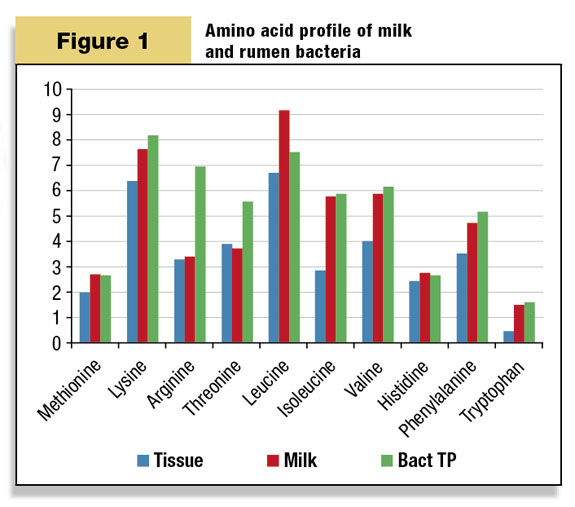Back in 1990, I worked with my first 90-pound dairy herd. It was a very high crude protein diet (22 percent) and contained 42 pounds of grain in only 56 pounds of dry matter intake, making the ration a mere 33 percent forage. Fortunately for the cows, several pounds of soyhulls and cottonseed made up a large proportion of the TMR grain mix, helping to maintain rumen health.
Recently, I did a diet for 110 pounds of milk that was only 16.6 percent CP, contained just 24.8 pounds of grain and was a healthy, profitable 57 percent forage diet. How things have changed in 23 years! It is the purpose of this article to look at why we can today produce high levels of milk with relatively low levels of crude protein (CP).
First, let us take a step back and ask how protein drives milk production. The mammary glands produce milk when they have an adequate flow of individual amino acids to incorporate into milk production.
These amino acids can come from two different sources – the amino acids escaping digestion in the rumen or bypassing, commonly called rumen undegradable protein (RUP), or from the digestion of the rumen bacteria protein, commonly called microbial protein (MP).
For years, nutritionists just overfed crude protein with various amounts of RUP in the diets to be sure they met this amino acid requirement for the desired milk level. Imagine, if you will, overflowing a five-gallon bucket to make sure it is completely full. The overflow is wasted.
There are several problems with this method of feeding cows. The obvious problem is the total cost of overfeeding CP. The old rule of thumb says a pound of purchased protein cost the dairyman about $0.35.
If you go from an 18 percent to a 16 percent CP diet at 56 pounds of DMI, that is 1.12 lbs of protein less or about $0.40 per head per day. This is serious cash for today’s tight dairy margins.
Another problem is the cow herself. When we overfeed protein, the excess nitrogen has to be converted into urea to be eliminated. There is an energy cost to this biochemical process and is the basis for a popular human diet where we eat high-protein foods and lose weight.
We do not want cows losing excessive bodyweight when we are asking her to peak, to breed and to persist after peaking, so we can either cut the CP to minimize this bodyweight loss or add more expensive fat to offset this loss.
Today, a quarter-pound of bypass fat is going to cost the dairyman around $0.20 per head per day. If we put both costs together, overfeeding protein can easily add $0.60 to $0.80 per head per day to our total feed cost, depending on how much protein we are overfeeding and how much fat we fed to offset this excess protein bodyweight loss.
How do we lower CP in today’s diets? Remember that the needed amino acids can come from either the RUP or from the digestion of MP. If we maximize the growth of this MP, we can then lower the RUP and the CP we feed. Several modeling programs calculate MP based on the nitrogen (protein) and the fermentable carbohydrates (energy) that rumen bacteria need to grow.
In reality, we balance two diets – one to feed the rumen bacteria (MP) and the other to feed the cow in which the bacteria are part of. A typical diet can grow 1,200 grams (2.6 pounds protein) of MP. At 2.6 pounds and $0.35 per pound of purchased protein, that works out to be nearly $0.93 per cow per day of protein cost just coming from the MP.

If you look at Figure 1 , you see the amino acid profile of these rumen bacteria compares closely with the amino acid composition of milk. If I can improve the growth of these rumen bacteria in my diet and grow 1,500 grams of MP, I cut protein cost by another $0.25 per head per day.
Because the MP has a better amino acids profile (better than I can get from purchased protein mixes), she can produce more milk with less CP.
Another factor that plays into how low we can go on CP is increasing the neutral detergent fiber digestibility (NDFD) of the forages fed. There is always some protein trapped in the forage NDF (measured by the lab as NDF-ICP) and the higher the NDFD of a forage is, the more of this trapped protein is available to meet the cow’s protein requirements.
While not very high in corn silages, haylages can have 4 to 6 percent NDF-ICP. If we go from 40 percent to 60 percent NDFD in a haylage mix that is at 5 percent NDF-ICP and feed 10 pounds of DM, then that is another 0.10 pounds per head per day of CP I do not have to feed or another $0.04 per head per day savings.
While this is not a huge savings, the larger improvement is that another 0.80 pounds of fermentable NDF (carbohydrate source) in our haylage example is able to grow even more MP, saving the dairyman substantially in energy cost, plus with the increased MP we can lower even more CP in the diet, saving more money yet. Knowing your forage NDFD pays big dividends.
The biggest single factor allowing us to lower CP in dairy diets is the recent introduction of rumen-bypass methionine and lysine products. These two amino acids are considered by most nutritionists to be the most limited amino acids in modern dairy diets.
Their addition in diets allows us to feed just the correct amounts of amino acids to meet requirements with even lower CP in the diets. Think of filling our five-gallon bucket to the rim but not overflowing it nor wasting any.
The dairy industry is following the trends of the swine industry. Many years ago, we fed a 16 percent CP pig grower to the pigs starting on the finishing floor. Today, the swine industry is only feeding a 13.6 percent CP diet, but it is full of synthetic amino acids so it acts just like the old 16 percent CP diet.
We are feeding sub-16 percent CP in dairy diets that act just like the old 18 percent CP diets without the negative side effects of overfeeding protein.
Nitrogen efficiency is measured as pounds of protein leaving the cow divided by the pounds of protein going into the cow x 100. If a cow is giving 75 pounds of milk at a 3.15 percent true milk protein, that is 2.36 of protein leaving the cow.
If she eats 56 pounds of DM and an 18 percent CP diet, then she is eating 10.08 pounds of CP. If we take 2.36 / 10.08 x 100, we get 23 percent nitrogen efficiency.
Every dairy farm should have a goal of at least 26 percent nitrogen efficiency. If your dairy is less than 25 percent nitrogen efficiency, you are not utilizing the CP you are feeding to its fullest extent. This unused nitrogen will end up in the manure and will require more acres to spread the manure over, making it tougher to meet your nitrogen nutrient management compliance quotas.
Understanding protein requirements for both the rumen bacteria and the high-producing cow will help you be more profitable.
Think more about filling that five-gallon bucket to the rim by concentrating on amino acid composition of both the diet and maximizing rumen bacteria growth with higher digestible forages. By not overfilling the bucket, cows are more efficient, produce more milk and help lower environmental concerns. PD

-
Steve Massie
- Western Field Nutritionist
- Renaissance Nutrition
- Email Steve Massie






